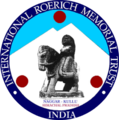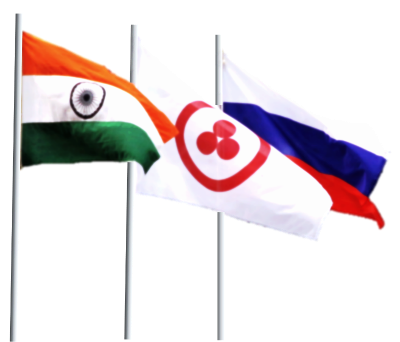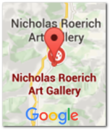30.05.2017
Art Camp and Seminar on the Roerichs Inaugurated at the RCSC in New Delhi
Addressing the gathering of artists, art critics, Russian compatriots, language students and others, Chief Guest Mr. Jatin Das said that the Art Camp is unique with the salient feature of the participants belonging to amateur and professional categories of artists with a new spirit, enthusiasm and inspiration reflecting in the venture. He recalled his first trip abroad to the erstwhile Soviet Union in 1962 which left an indelible impression on him due the importance given in that country to art.
The Seventh Series of the three-day Art Camp titled “Indian Artists Paint Russia”, jointly organised by the Russian Centre of Science and Culture (RCSC) and the Forum of Indian Photographers and Artists (FIPA) on the theme “Roerich Family – Connection between Russians and Indians”, was opened on May 29, 2017. The Art Camp, aimed at marking the 70th Anniversary of the Establishment of Diplomatic Relations between Russia and India, was dedicated to the 25th Anniversary of the International Roerich Memorial Trust, Naggar, Kullu, Himachal Pradesh.
Padma Bhushan M. Jatin Das, eminent Indian artist, was the Chief Guest on the occasion. Fifteen artists from North India participated in the Art Camp. The participants were a mix of young talents, established professional artists and amateur artists in the age group 22-62.
Mr. Vimal Mehta, President, FIPA, said that the Art Camp of such nature was held only at the RCSC in New Delhi and no other RCSCs around the world. He hoped that such joint programmes would be organised in other SAARC countries in future.
As a mark of opening the Art Camp, Mr. Jatin Das, with the stroke of his brush on the canvas, made an acrylic sketch of a lady striking a dancing pose.
A Seminar-cum-Panel Discussion on “The Global Importance of the Roerichs’ Cultural Heritage” was held at the Russian Centre of Science and Culture (RCSC) in association with the Forum of Indian Photographers and Artists (FIPA) on May 30, 2017. Distinguished speakers such as Dr. Susmita Lakhyani, Associate Professor in Arts, Department of Education, Delhi University, Ms. Harsh Inder Loomba, Research Fellow (Social Impact of Art), Ministry of Culture, Government of India, Dr. Suman Dudeja, Associate Professor, Chemistry, ARSD College, Delhi University, and Ms. Juhi Kumar, Artist, addressed the seminar. The scholars, who are experts in Roerich philosophy, presented their own perspectives on the significant contribution made by the Roerichs, which assumes new dimension in the context of the Roerichs’ legacy and their impact on Indian life, history and culture. Mr. Vimal S. Mehta, noted artist and President of FIPA, was the moderator.
Speaking on the occasion, Mr. Sergey V. Karmalito, Senior Counsellor, Embassy of the Russian Federation in India, noted that the Art Camp assumed special importance as having been organised within the framework of the 70th anniversary of Russian-Indian Diplomatic Relations and dedicated to the 25th anniversary of International Roerich Memorial Trust. A number of cultural events were being organised across the country to mark the 70th anniversary of diplomatic relations, he added. M. Karmalito further said that the forthcoming Summit Meeting between Vladimir Putin and Narendra Modi at St. Petersburg on June 1 and the subsequent Indo-Russian Business Forum within the framework of the St. Petersburg International Business Forum on June 2 are significant in the context of the development of bilateral relations.
Ms. Harsh Inder Loomba traced the ancestral background of Nicholas Roerich, the first Russian Cultural Ambassador to India, eminent Russian painter, writer, archaeologist, theosophist, an enlightener, philosopher and public figure. She added that he was influenced by a spiritual movement in the Russian society, took interest in various spiritual practices, and his paintings are said to have hypnotic power.
Ms. Juhi Kumar brought into focus the contribution of Helena Roerich, philosopher, writer and public figure, who in cooperation with the spiritual teachers of the East, brought out the series of books under the umbrella title of Living Ethics (Agni Yoga) and a monograph Foundations of Buddhism (1926). Helena Roerich took part in all the expeditions and explorations undertaken by her husband, Nicholas Roerich. She described George Roerich as the prominent 20th century Tibetologist, well known for his monumental translation of Blue Annals and the 11-volume Tibetan-Russian-English Dictionary.
Dr. Susmita Lakhyani narrated as to how Nicholas Roerich was influenced by the works of Shree Ramakrishna, Swami Vivekananda, Rabindranath Tagore and Bhagavat Gita. The famous Central Asian Expedition (1924-1928) was a turning point of his life. He received Jawaharlal Nehru and Indira Gandhi at his estate in Naggar, Kullu, where the family settled in 1928. He established the ‘Urusvati’ Himalayan Research Institute at Darjeeling in 1928, which later moved to Naggar, Kullu. On April 15, 1935, the Roerich Pact was signed by the American states, members of the Pan-American Union. He died in Naggar, Kullu, on December 13, 1947 and was cremated there.
Dr. Suman Dudeja in her paper described different perspectives on the colour combination in Nicholas Roerich’s paintings, their harmony, rhythm, etc. She underlined the significance of the Roerich Pact in the context of preservation of cultural heritage. Pointing out that Helena Roerich was the major support of Nicholas Roerich in all his expeditions and undertakings, she underscored the vibrant spirit and dynamic essence of Agni Yoga. She described Svetoslav Roerich as a prominent painter. Pandit Jawaharlal Nehru awarded him the Jawaharlal Nehru Award. Padma Bhushan, the highest Indian award in the field of arts, was conferred on him later. His portraits of Nehru and Indira Gandhi adorn the Central Hall of the Indian Parliament House. He married Devika Rani, the first lady of Indian screen. He devoted his life to the preservation of the heritage and legacy of his illustrious family.


















